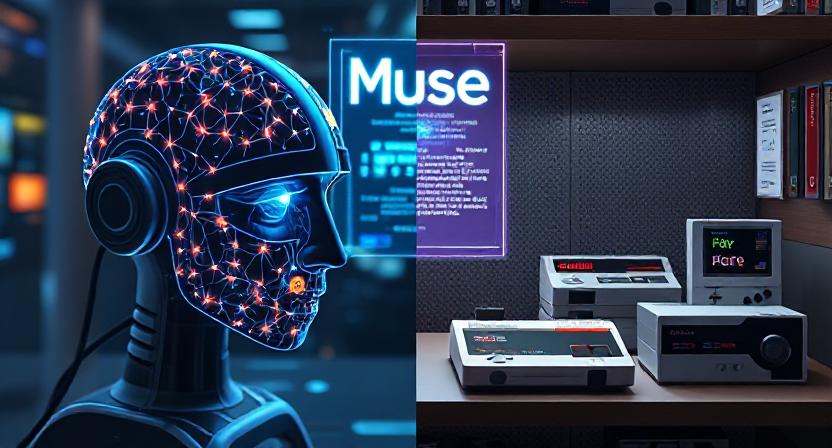Muse by Microsoft: Scenes from Bleeding Edge

Microsoft’s Muse: Generative AI That Predicts Gameplay Visuals from Controller Data and What It Means for Security In February 2025 Microsoft unveiled Muse, a groundbreaking...
⏱️ Estimated reading time: 5 min
Latest News
Microsoft’s Muse: Generative AI That Predicts Gameplay Visuals from Controller Data and What It Means for Security
In February 2025 Microsoft unveiled Muse, a groundbreaking generative AI model developed in collaboration between Microsoft Research, Ninja Theory and the WHAM World and Human Action Model team. Designed for gameplay ideation not content replacement Muse is trained on over 1 billion images and controller-action pairs from the Xbox game Bleeding Edge, representing seven years of continuous human gameplay.
- Currently, Muse generates low resolution 300×180 px 10 fps gameplay clips that replicate the visual world based on controller inputs a feature known as world model mode.
- Additionally, Muse can predict controller actions based on game visuals a capability referred to as behavior policy mode.
- Generating both visuals and controller inputs from scratch in full generation mode.
Microsoft positions Muse as a tool to accelerate prototyping, preserve older games for future platforms, and empower creative iteration not to replace human developers or automate entire game creation.
How Muse Works: Technical Overview
Muse is grounded in a transformer-based architecture with 1.6 billion parameters. It integrates a VQ‑GAN encoder decoder to discretize visuals and a transformer to sequence actions and observations.
Training data came from anonymized gameplay of nearly 28,000 players across seven maps in Bleeding Edge producing one billion observation‑action pairs at 10 Hz. Context length spans approximately 10 of these pairs 5,560 tokens.
While its visuals remain low-resolution, Muse is capable of generating consistent, physics-aware gameplay sequences and adapting them to small modifications like placing a new object or changing character position.
Security & Privacy Implications
Muse was trained on anonymized metadata from Bleeding Edge, with data collection permitted through player EULAs. While player identifiers were removed critics raise concerns about the scale of behavioral data captured potentially revealing playstyles or strategies at large scale.
Behavioral Fingerprinting
Since Muse learns how players act and from multiple participants there is theoretical risk that future models trained on similar datasets could re-identify behavioral patterns, especially if linked with other data sources raising concerns about behavioral privacy and fingerprinting.
Intellectual Property & Model Replication
Muse’s ability to recreate gameplay visuals could raise IP concerns. If trained on proprietary titles, reproduction even in low fidelity could infringe on licensing rights. Microsoft limits usage of Muse output to in‑game contexts watermarking generated frames to deter misuse.
Model Misuse & Evasion
In theory adversaries could use Muse-like AI to simulate gameplay for testing hacks, exploits or automated agents without running the actual game. Safeguards should be in place to prevent using such AI to map game logic or vulnerabilities illicitly.
Creative Value vs Job Risk
Microsoft emphasizes Muse as a tool supporting creative iteration and game prototyping, rather than replacing developers. Studio leads emphasize that AI should free up designers to focus on artistry not automation tasks.
Nevertheless developers at large express nervousness. Some fear the tool may devalue years of craft based knowledge and worry AI driven optimization may favor shareholder interests over human creators. Others question Muse’s practicality given its reliance on enormous, game specific gameplay datasets.
Use Cases: Preservation, Prototyping, and Pipeline Insight

Game Preservation
Microsoft proposes that Muse could help preserve classic games by emulating behavior without needing original hardware. However critics argue it’s at best a curatorial aid not full archival fidelity. Real preservation still requires assets code and emulation.
• Prototyping Workflow
Muse can generate variations on level design, movement behaviors or environment tweaks based on a few frames of input helping developers visualize ideas before full implementation. Within the WHAM Demonstrator users can tweak gameplay lanes directly using controller input.
Designer Visualization
Game creators interviewed globally helped shape Muse’s design, ensuring it aligns with creative needs across diversity of studios. The model supports iterative visual storytelling and early ideation sessions.Microsoft, Towards AI
Limitations & Considerations
- However, Muse is trained solely on Bleeding Edge. Therefore transferring it to other genres or games would require massive new datasets.
- Additionally, the outputs are limited to a fixed 300×180 resolution which is still far from AAA visual quality.
- Moreover, inference is slow real time generation runs at just 10 fps, making it unsuitable for production gameplay.
- Additionally, bias and out‑of‑scope behavior are evident generations outside the original domain often collapse into abstract blobs or meaningless visuals.
What Comes Next?
Microsoft is exploring extending Muse to first-party franchises and even deploying prototypes in Copilot Labs signaling early public experimentation.
- Moreover, expanding to diverse titles could enable reality based world model interfaces across different genres.
- Consequently, integration with AI assistants in development pipelines seems likely for prototyping, QA or accessibility features.
- As AI improves, moreover higher resolution and faster versions could become viable in live screening. However this advancement may also raise new privacy and security challenges.
Final Thoughts: Muse at the Crossroads of Creativity and Risk
Microsoft’s Muse represents a pioneering experiment in generative gameplay AI. By learning from controller inputs and visuals alone, it opens doors to faster iteration and novel creative tools for game developers. Its potential applications in preservation and prototyping are exciting but only if balanced carefully with user privacy, intellectual property safeguards and respect for human creativity.
As Muse matures responsible deployment and transparent governance will be essential. Game studios AI researchers and policymakers alike must collaborate to ensure such tools empower creators without undermining ethics or developer livelihoods. For now Muse stands as a bold next step in imagining what gameplay generation could one day become grounded in data shaped by design and accountable to both creators and players.
Related Posts

US, UK, Australia Sanction Russian Web Host
Crackdown on Russian ‘Bulletproof’ Web Host The United States, United Kingdom, and Australia have jointly...
December 6, 2025

Meta to Shut Down Underage Accounts in Australia
Meta to Close Teen Accounts in Australia Amidst Social Media Ban Meta has commenced notifying...
November 25, 2025

DoorDash Data Breach: User Data Exposed
DoorDash Confirms Data Breach Affecting User Data DoorDash recently confirmed a data breach that exposed...
November 17, 2025











Leave a Reply